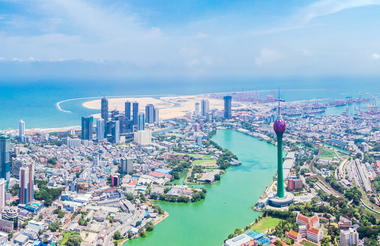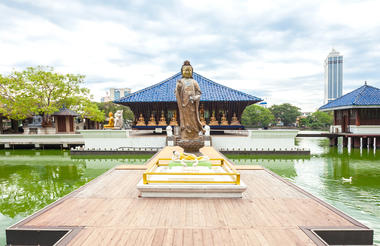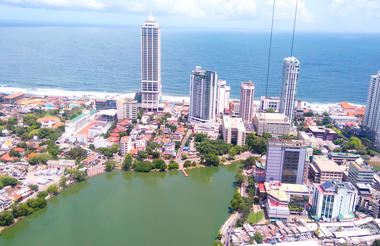You will be met at the airport by our representative and introduced to your chauffeur guide who will be accompanying you on your tour.
The drive time is approximately 3.5 hours.
We have not made any arrangements for you on this day.



Cycle Through UNESCO Site (Full Experience)
Ancient cities don’t get much bigger than Anuradhapura, and few capitals around the world have ever been as long lasting. Dating back to the fourth century BC, Anuradhapura was the spiritual and secular capital of the island for well over a millennium. At its height, the city was dotted with monasteries and home to over 10,000 monks, many of these monasteries and colossal dagobas can still be seen today.
Cycle through more than a dozen archeological sites of the ancient kingdom of Anuradhapura with a local guide who has spent much of his time in this part of the island. Ride alongside scenic paddy fields, hidden villages and cleverly thought-out irrigation systems which have withstood the test of time. Pedal around some of the most architecturally stunning structures including Abayagiri Dagoba, the largest Buddhist monument in the world. Along the way stop at the Elephant Pond to enjoy a scenic picnic overlooking the pond. After the picnic, guests have the option of continuing the ride. You will also visit the Jaya Sri Maha Bodhi tree, a branch of the historical Sri Maha Bodhi in India under which Lord Buddha attained Enlightenment.
- Includes: Guide, bikes, helmets and refreshments
- Duration: Approx. 3 to 4 hours
- Difficulty: Moderate. We rank it as moderate because of the heat.
- Suitable for children: Recommended for children over 8 years, baby seats and tuk tuks can be arranged
- Times: 8.30 AM or 3.00 PM
- What to wear or bring along: Light clothing, sun cream, a hat. You might want to bring a change of shirt or t-shirt.
- Important to know: The terrain is flat. If you have any injuries or physical restrictions with biking please let your guide know in advance.
- Private or not? The visit is private. That said, there may be other people around at the site.



Morning
Cycle Through UNESCO Site (Full Experience)
Morning & Afternoon Jeep Safaris at Wilpattu National Park
The park is situated along the Northwest coast lowland dry zone of Sri Lanka. It comprises of a unique complex of lakes called Villus, which are natural basins that are filled up with rainwater and are surrounded by open grassy plains set within dense scrub jungle. A multitude of sandy paths wind around the entire park and open up into these large natural lakes. The unspoilt and beautiful Wilpattu National Park is one of the largest and oldest National Parks in Sri Lanka. It is ideal for those wanting to escape the flurry of activity of Yala and instead offers the opportunity for a tranquil, peaceful and undisturbed drive.
The biggest draws in Wilpattu are Leopards and Sloth bears. Alongside these, it is possible to see Asian Elephants, Spotted Deer, Barking Deer, Wild Pig, Asiatic Buffalo and Mugger Crocodiles. Endemic birds include the Ceylon Junglefowl, Brown-capped Babbler, Ceylon Woodshrike and Black-capped Bulbul in riverine habitats. Muntjac or Barking Deer are more easily seen in Wilpattu than any other national park. Butterflies recorded include the Great Egg fly, Great Orange Tip, Glad-eye Bush brown, Blue Mormon, Common Mormon, Common Rose and Crimson Rose.



Morning & Afternoon Jeep Safaris at Wilpattu National Park
WILDLIFE CONSERVATION CHALLENGE - Human Elephant Conflict in Sri Lanka
Over the last three generations, the Sri Lankan Elephant population has declined by as much as 50%. Listed as endangered by the IUCN, current estimates suggest there to be around 6,000 Sri Lankan Elephants left on the island, with just under three quarters of these majestic creatures living outside protected areas. Habitat loss, and in particular, deforestation, has squeezed elephant ranges and brought them into conflict with rural communities. In 2019 alone, over 350 elephants perished as a result of an intensifying human-elephant conflict (HEC).



Morning
WILDLIFE CONSERVATION CHALLENGE - Human Elephant Conflict in Sri Lanka
Leave for Kegalle. En route visit Dambulla Rock Temple.
The drive time is approximately 3 hours.
Dambulla Rock Temple
The Dambulla Rock Temple was donated by king Walagambahu in the 1st century BC to Buddhist monks. Dambulla is a World Heritage Site and is the most impressive of Sri Lanka's cave temples. The complex of five caves with over 2000 sq. meters of painted walls and the ceiling is the largest area of cave paintings found in the world. These caves contain over 1500 images of the Buddha of which the largest is the colossal figure of the Buddha carved out of rock spanning 14 meters. Close to the town of Dambulla this attraction is easily accessed although it requires walking up a considerable number of steps to reach the caves from the road. If you are a little short of time, a visit to the Dambulla rock temple can be combined with travelling to or from the Sigiriya area.



Dambulla Rock Temple
Cooking Lesson
After a relaxed breakfast, at approximately 10:30 visit the organic kitchen garden with the Chef who, along with the gardener will explain the produce and some of the spices that is grown at Rosyth. On your return to the kitchen, you will have the opportunity to cook authentic Sri Lankan curries. You may be joined by other guests. The maximum number of guests is eight. The menu has been designed to include ingredients which are available in Europe. Your hands-on cooking class will include a fish or chicken curry and three other vegetable curries and a traditional salad. Sit down for lunch in the dining room in the canopy of the trees with the curries that you have cooked and enjoy your lunch with the rice and poppadum's. You will have the opportunity to take away the recipes to replicate at home. The curries: The main curries are Chicken, Fish or Mushroom. Green bean, Lentil and spinach, aubergine & Gotkola sambal. When you sit for lunch we will serve you red or white rice, popadoms and homemade chutneys. You will have the recipes to take home and we suggest you purchase the spices from a supermarket before you fly home.
Rosyth Artisanal Tea
You are invited to partake in the mindful practice of tea plucking, hand rolling and sipping tea. If you are with us for long enough, you can even take some home with you so you can continue with sipping tea at home.
At the Rosyth Estate House we have begun our journey to become an organic, artisanal producer of Sri Lankan tea. Removing mechanisation from our processes we have started to produce hand rolled tea which is carefully crafted on the estate by our local artisans. This project is wholeheartedly community focused as we look to improve the economic sustainability of our valley.
Join the ladies in our tea gardens which are spread around the estate. They start early (about 6am) but you might want to start a bit later. They will teach you the art of plucking; just buds or two leaves and a bud. Just buds - "golden tips" or "silver tips," tea tips are the small, unopened leaves of the tea plant are the sweetest part of the tea leaf. This is a great chance to interact with our local community and also understand the challenges that the ladies have in picking the freshest leaves. You will be unlikely to grab a tea bag again.
If you are just interested in learning how artisan tea is made, you will have the opportunity to hand roll the leaves, return to watch the next process where the tea is fermented and then dried . End with tasting the different teas that they produce,



Morning
Cooking Lesson
Afternoon
Rosyth Artisanal Tea
Elephant Freedom Project



Morning
Elephant Freedom Project
Leave for Yala.
The drive time is approximately 5.5 hours.
Afternoon Jeep Safari at Yala National Park
Located in the wild south-east part of the island, this region is a haven for flora and fauna and excellent game. The beaches are backed by large sand dunes giving rise to lagoons, woodland and scrub bush. The premier wildlife location in Sri Lanka, Yala offers an almost African safari experience as well as an important Buddhist temple site. On game drives by jeep, one can usually view wild elephant, buffalo and boar, huge monitor lizards, macaque monkeys and many rare and endemic bird species: it is also the best place in south Asia to spot the elusive leopard, often seen and admired. Lazing on a treetop, blending in perfectly with its surroundings, the big cat is almost invisible, yet the absence of tigers in Sri Lanka makes for a leopard with real attitude. Usually tagged ‘Prince of the Night’, this cat is well out of its normally nocturnal closet. Confident, it will stroll in the open by day, to every ecotourist’s delight. There are believed to be about 600 leopards across Sri Lanka today, mostly in the protected parks and reserves. Yala National Park has one of the highest recorded densities of leopards in the world, The Sri Lanka Sloth Bear-shaggy, shuffling and rather hunch-backed black bears may be seen loping around even in daylight and are endemic to Sri Lanka. This park is famous for its high density of leopards, perhaps the highest in the world. You are also sure to see elephants – grumpy loan males during the dry months and large herds in the wet season. Sloth bears are also a big draw. You will also see mammal such as wild boars, several species of deer and wild buffalo. There is a plethora of reptilian species and platoons of crocodiles. As is common in Sri Lanka there is a huge diversity of stunning birdlife including migratory species such as the flamingo. It is also one of the few places in the world where the severely endangered black necked stork can still be seen. The uniqueness of the park is the sheer diversity of the habitat: dense jungles suddenly gives way to lagoons and open plain areas and the park has a simply beautiful sea front. Huge, stark boulders dominate the horizon and the elegant, languorous leopard can often be seen basking atop the sun baked rock.



All Inclusive Includes:
Accommodation
Morning game drive & evening game drive in customized safari game viewing vehicle
All park entry fees
Refreshments included on game drives
Transfers to and from park entrance to resort
Breakfast, Lunch & Dinner at resortWater, fruit juices& other soft drinksTeas and coffees Selected wine, beer and spiritsMini Bar (replenishedonce daily)Laundry(6 pieces percabin perday)
Not included in the All Inclusive:
Telephone Calls
Safari shop purchases
Gratuities
Champagne, cognacs, fine wines and premium brand spirits
Cigars
Morning & Afternoon Jeep Safari at Yala National Park
Jeep Safari at Bundala National Park - Optional
Bundala National Park provides a tranquil environment for bird enthusiasts, with a diverse list of species of birdlife that include grebes, cormorants and darters, herons and bitterns, ducks and geese, snipe, plovers, curlews, sandpipers, terns and stilts; not forgetting the raptors, bee-eaters, parakeets, kingfishers, swifts and shrikes. A visit to the Bundala National Park in January is worth a trip to see migratory birds from Russia, Eastern and Northern Europe and the Himalayas, Mongolia and from across Asia beating the winter blues in sunny Sri Lanka.
Watching birds on a cool morning by the lagoon is a treat for a bird lover. A display of brisk action like Spoonbills with zigzagging beaks stirring grub along shallow waters, Painted Storks forking out mud, a pair of Whistling Teal escorting their brood across the water, a young Brahminy Kite impressively holding onto its sizable catch from the water; and the spectacle could go on endlessly.
The serenading sounds of the Indian Pitta resonates the surrounding while it is the courting season for the Peacocks, with the males putting on a no holds barred display of plumage. Bundala is also home to other species of animals, such as deer, wild boar, Grey Langurs, a small population of elephants and a sizeable population of mugger crocodiles. The coastline that borders the park provides breathtaking scenery of cliff tops and sand dunes.
The sand dunes are a protected area as four species of turtle come ashore to lay eggs. A stay at one of the camp sites inside the park during the season will be rewarded with unlimited entertainment of birds in action and animals engaged in their breeding rituals.
Time of departure: 5.30 am leave Uga Chena Huts for Bundala National Park
Duration: Arrive at Bundala National Park entrance at 6.15 am
What is included:
Game drive on Bird Watching. Some elephants can also be seen
Stop at the beach inside the park for some snacks and drinks.
Return to Uga Chena Huts by 11.30 am (Depending on guests)



Morning & Afternoon Jeep Safari at Yala National Park
Morning
Jeep Safari at Bundala National Park
Morning & Afternoon Jeep Safari at Yala National Park



Morning & Afternoon Jeep Safari at Yala National Park
Morning & Afternoon Jeep Safari at Yala National Park



Morning & Afternoon Jeep Safari at Yala National Park
Leave for Colombo. En route visit Galle Fort.
The drive time is approximately 5 hours.
Galle Fort Walking Tour
Before the Dutch took Colombo from the Portuguese, Galle was their headquarters. Contrary to the Colombo Fort, the one in Galle was not only not demolished, but is one of the best preserved examples of 17th century colonial fortifications in the world, and is on the UNESCO list of World Monuments. The reason for its remarkable state of preservation is that this once busy trading town, visited by the East-India fleets and many regional traders, fell upon slack times after the Dutch had left. The development that did take place focused on the new town of Galle, outside the Fort.
The Fort is really a walled city, with a rectangular pattern of streets full of the low houses with gables and verandas in the Dutch colonial style. An irony of history is that most of the inhabitants of old Galle, occupying the houses of the Dutch, are the descendants of the Muslim traders that the Dutch despised so much for their petty trade that violated their monopoly. The Muslims have adapted many of the houses to their own likings, closing up the verandas with woodwork to prevent their women from being seen from outside. Recently it is no longer allowed to alter any of these houses, some renovation is taking place, and private museums with handicraft shops have even been established.
There are also several interesting buildings from early British times, and an early 20th century light tower. The fort was started by the Portuguese in 1588, but there is nothing recognizably Portuguese left. Probably parts of the thick walls, that you can walk on almost all around the town, in the sunshine and the cool breeze, with the red-tiled roofs of the houses on the one hand, and the blue ocean on the other.



Morning
Galle Fort Walking Tour
Colombo Walking Tour with Mark Forbes
Colombo's amazing Fort district still has the energy like in the late nineteenth century when the streets were teeming with ox carts and alive with the sounds and whiffs of the sea, as rubber, tea, cinnamon, kittul treacle, rope and peacocks were loaded aboard ships. Take a walking tour of the Colombo's historic Fort district Learn about the city's colonial past and pick up some photography tip Sample some fiery street food! Recap your walk over iced cold beers at the Dutch Hospital Complex Taking a walking tour is one of the best things to do in Colombo city and Mark, a Colombo native, has hosted walks in Colombo for several years under the Colombo City Walks banner. Starting at the Dutch Hospital Shopping Complex in Fort and walk along the old colonial streets, away from your usual tourist spots, and seek out the colonial Dutch mansions and be a part of the history that is now commercial hub of Colombo. Explore the old Cargills building, visit the New Chinese shop, snap a picture outside the Pagoda Tea Rooms where Duran Duran filmed their iconic music video, Hungry like the Wolf, and enjoy a cup of Ceylon Tea on the balcony of the Grand Oriental Hotel while taking in the sunset views of the Colombo Harbor. End your walk back at the Dutch Hospital, formerly a hospital during the 17th century, the complex is now host to high-end restaurants, bars and shops. Relax, take a breather, and admire the architecture.



Morning
Colombo Walking Tour with Mark Forbes
Returning to the UK
Today you will be transferred to the Airport for the departure flight. Our local representative or driver will be in touch to confirm the pickup time a day before your departure. We normally recommend aiming to be at the Airport 3 hours prior to departure.
The drive time to the Airport is approximately 1 hour.




